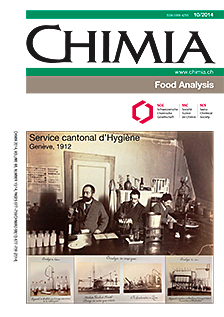Microsatellite Analysis of Perch (Perca fluviatilis) and its Genetic Authentication of Geographical Localization
DOI:
https://doi.org/10.2533/chimia.2014.726Keywords:
European perch, Food authentication, Geographical origin, Microsatellite, Statistical analysisAbstract
European perch (Perca fluviatilis) is an economically important freshwater species in Europe. In Switzerland, where the demand largely exceeds the production coming from Swiss lakes, nearly 90% of the requirements come from importation with the majority of perch originating from Estonia and Russia. The price of perch fillet varies considerably depending on the origin. Therefore traceability in the fish food sector plays an increasingly important role for consumer protection. Currently the traceability of perch can be assessed through chemical isotopic analysis. The 180/160 isotopic abundance ratio is used as geographical traceability marker, but several aspects affect the accuracy of the method, i.e. the distinct geographical area ratio differs only very slightly with overlapping standard deviation, the need for a large amount of fish material requires the mix of many fillets, the impossibility of analyzing processed matrix, the comparison of the ratio with the ratio of a sample of the presumed originating water makes the analyses more complicated. New application of DNA markers for the traceability of food products plays an increasingly important role for consumer protection. Microsatellites, which are short tandemly repetitive DNA sequences, are genetic markers of choice for traceability because of their abundance and high polymorphism. Moreover, fluorescent labelling and capillary electrophoresis separation increase efficiency and precision of genotyping microsatellites. The method can also be efficiently applied in processed food products where other methods have limited applications. In this study, we tested the efficiency of three polymorphic microsatellites and their combinations for their ability to correctly assign or exclude 195 reference perch to their origin population. Using the maximum likelihood and Bayesian methods computed by the software GeneClass2, the three loci microsatellite were optimized and allowed the correct assignation of all but two Swiss perch (60/62) into Swiss population. The markers also exclude 132/133 imported fish from the Swiss population with a match probability of more than 95%. The number of markers required for correct assignation differs from species to species, and depends on many factors such as genetic diversity and population structure. For perch populations, the results showed that only three polymorphic microsatellite markers are required to perform a reliable attribution or exclusion of a perch to the Swiss population with more than 98% correct assignations.Downloads
Published
2014-10-29
How to Cite
[1]
J. Rolli, S. Girardet, C. Monachon, C. Richard, Chimia 2014, 68, 726, DOI: 10.2533/chimia.2014.726.
Issue
Section
Scientific Articles
License
Copyright (c) 2014 Swiss Chemical Society

This work is licensed under a Creative Commons Attribution-NonCommercial 4.0 International License.







